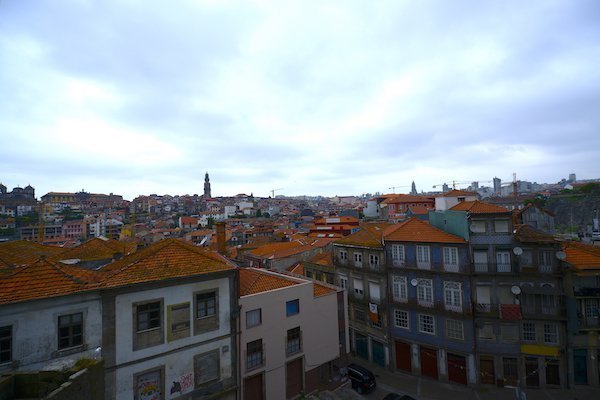Porto or Oporto, is on the Douro River estuary in northern Portugal, with the centre being a UNESCO World Heritage Site since 1996. It is a fabulous city to visit, preferably out of the summer season.
The centre is split by the Douro river, on one side the Port cellars and the boats, barcos rabelos (Vila Nova de Gaia) used for transporting the Port barrels and the other side is the main centre of the city (Ribiera).
Trade with Great Britain has been a long-time thing, in fact since 1717 and you cannot help noticing that most of the Port cellars have names which are more English than Portugese.
If you are wondering if Porto is a place to visit, Porto won the European Best Destination 2012, 2014 and 2017 awards, so it can’t be that bad, can it.
Transport in Porto is excellent, taxis are not expensive & the buses run frequently and are cheap – 1.85€ a trip.
There are lots of hotels in Porto, many at very reasonable prices. We stayed at HF Tuela Porto Ala Sul, it’s a bit far from the old town and the river, but it’s worth it. The staff are excellent, efficient, friendly and helpful. The rooms are nice, but don’t expect a great view, as there aren’t really any. It didn’t bother us as we were out all day every day and Only came back to sleep and shower. They prepare a buffet breakfast, which is good value for money.. There are fresh fruits and a wide variety of drinks. The scrambled eggs taste like they came out of a package and the susages are sausages, but you don’t come to Porto for an English breakfast and you will find something you like here.
Do not be put off by the fact that it is a little way from the city center because buses run nearby and taxis are very cheap in June 2018 between the hotel and the old town at 1 am 6 €!
If you are in Porto, you must try the local specialities, bacalhau com natas (cod with cream), Francesinha, a sandwich filled with four or five different meats, covered in cheese and drowned in sauce, and if that wasn’t enough, they are served with chips! Tripas à Moda do Porto tripe cooked with beans, sausage, vegetables, and herbs, if you are in Porto, it is only natural that you try a dish named after the city. Caldo verde, kale soup, is a simple recipe. It’s not all vegetables, however, and is normally flavored with Portuguese chouriço, thickened with pureed potatoes and flavored with garlic and you must try a drink or a snack in The Majestic Café.
Try and find a place to see some Fadò, it is really fabulous, although perhaps more a tradition on Lisbon than Porto.
We reserved for the Fadó evening at a restaurant called Vinhas D’ Alho, with a great view over the river on the Cais da Ribeira.
When we seated the waiter ambushed us with two glasses of Porto and a selection of tapas, which we were a little surprised at – but it seems to be their ploy to get people eating and drinking quickly. I would have much preferred to order this from the menu …
Anyway, the meal was a little strange – a tounedos of veal, covered in some sort of rancid tasting cheese sauce – which, frankly was weird. I couldn’t eat it, it was terrible. The waiter changed it for what I ordered, tournedos without the rancid sauce. It was ok, but nothing exceptional. My wife had grilled bass, which was OK too.
The Fadó, on the other hand, was excellent.
The meal was expensive, for what it was and I can’t get over the fact that you pay for tap water and bread – maybe I’m too used to how things happen in France, where this is free!
Go for the fado, but choose carefully from the menu, and you can refuse the tapas and order your own, there, you are warned.
One place that must not be missed, strangley enough, is the railway station, Campanhã station, for the fabulouus ceramics in the entrance hall, just a 2 minute walk from here is the Clérigos Church and Tower – yet more beautiful architecture and the ubiquitous ceramics that you will see all over Porto, don’t miss Porto cathedral, Sé do Porto, built in the 12th century, nor the Saint Nicholas church (Igreja de São Nicolau), which was rebuilt in 1762.
The best-known museums of Porto are the National Museum Soares dos Reis (Museu Nacional de Soares dos Reis), which is dedicated especially to the Portuguese artistic movements from the 16th to the 20th century, and the Museum of Contemporary Art of the Serralves Foundation (Museu de Arte Contemporânea).
Porto has the largest synagogue in the Iberian Peninsula and one of the largest in Europe – Kadoorie Synagogue, opened in 1938.
This historic area includes the cathedral with its Romanesque choir, the neoclassical Stock Exchange and the Manueline-style Church of Santa Clara. The entire historic centre has been a National Monument since 2001. The “Historic Centre of Oporto, Luiz I Bridge and Monastery of Serra do Pilar” is a Unesco World Heritage site.
We went to a bar called La Casa Agricola, there is a nice bar downstairs, although a little smokey as Portugal has a weird law about keeping part of the bars for smokers – unfortunately the smoke doesn’t stay in the smokers part of the bar… There are tables outside too for a drink or a snack. The restaurant above the bar is excellent and very good price to quality ratio. We had a lovely meal with great service and I fully recommend it!
It is very nice to walk along the Cais da Ribeira, where there are restaurants and bars bot during the day and in the evening, but it can get a little crowded.
In the the Waterfront Plaza of Matosinhos there is an unusual sculpture, She Changes by American artist, Janet Echelman, which is worth seeing.
It is also a must to cross the high Luiz Bridge, either on foot or in a tram – the view over the city is fabulous and crossing it leads to a park which also gives excellent views over to the Ribiera side and the historic centre of Porto.
Take the heritage tram, from just below the covered market to the Atlantic side at Foz, where there are some very nice bars and restaurants virtually on the beach, with walks along the seafront to the beauutiful blue ocean.
If you like markets, go to the Mercado do Bolhão which is also open on Sundays and is famous for fish and vegetables – stop for a snack of fresh seafood.
Porto is best done on foot and public transport, the tourist areas are not huge, but Porto has some quite steep hills that converge on the river – a boat trip is also another good way to see another view of the city.




































































0 Comments